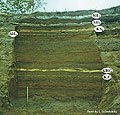1000-272
54o45’N, 157o23’E, summit elevation 2000 m
Khangar volcano is located in Sredinny Range. Earlier this volcano was regarded as extinct and was not included into catalogues of active volcanoes. Khangar is a Late Pleistocene stratovolcano nested in a large caldera and dotted with extrusive domes. Its summit crater is 2.1 x 2.8 km large and is filled with the lake 150 m deep; the upper part of an inter-crater extrusive dome(s) forms three small islands in the lake (Fig.1).
Khangar is noted for a large explosive eruption (KHG), which took place about 6900 14C yrs BP and was the largest event in the Holocene history of the volcano. This eruption produced 12-15 km3 of tephra, which formed fall, flow and surge deposits. Distribution of flow deposits was restricted by a rim of a large caldera enclosing Khangar volcano (Fig.2). Air-fall was dispersed mainly northeast of the volcano and is one of the most important markers for the Holocene stratigraphy (Figs. 3 and 4).
At least nine more Holocene tephras from Khangar have been identified around the volcano (Bazanova and Pevzner, 2001). The most recent eruption took place only about 400 years ago. These data suggest that Khangar repetitively resumed its activity during the Holocene, and should be regarded as currently dormant, but potentially active and thus, potentially hazardous volcano.
Holocene erupted products are mid- to high-potassic hornblende- and biotite-bearing dacite-rhyodacite.
Next eruption is likely to have phreato-magmatic character and can cause serious environmental impact. Ash-falls will damage pastures and hunting areas located at the foot of the volcano. Even a small eruption can cause catastrophic lahars resulting from the draining of the crater lake with the total volume of water of about 0.4 km3 through the weakened western crater wall, and then out of the large caldera down Heivan river.
Literature
Melekestsev IV, Braitseva OA, Bazanova LI, Ponomareva VV, Sulerzhitsky LD (1996) A particular type of catastrophic explosive eruptions with reference to the Holocene subcaldera eruptions at Khangar, Khodutka Maar, and Baraniy Amfiteatr volcanoes in Kamchatka. Volcanology and Seismology, 18, 135-160.
Bazanova LI, Pevzner MM (2001) Khangar: One more active volcano in Kamchatka. Transactions (Doklady) of the Russian Academy of Sciences, Earth Sciences, Volume 377A, March-April, p. 307-310
Braitseva OA, Melekestsev IV, Ponomareva VV, Sulerzhitsky LD (1995) The ages of calderas, large explosive craters and active volcanoes in the Kuril-Kamchatka region, Russia. Bull Volcanol 57 (6): 383-402
Braitseva OA, Ponomareva VV, Sulerzhitsky LD, Melekestsev IV, Bailey J (1997) Holocene key-marker tephra layers in Kamchatka, Russia. Quaternary Research 47/2: 125-139
Braitseva OA, Sulerzhitsky LD, Ponomareva VV, Melekestsev IV (1997) Geochronology of the greatest Holocene explosive eruptions in Kamchatka and their imprint on the Greenland glacier shield. Transactions (Doklady) of the Russian Academy of Sciences. Earth science sections. 352/1: 138-140





